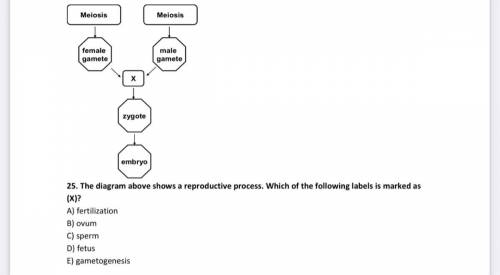7. Gene expression may be regulated:
A) only during translation
B) only during transcription<...

7. Gene expression may be regulated:
A) only during translation
B) only during transcription
C) during transcription and translation
D) only during replication
E) during replication and transcription
8. During anaphase of meiosis I toward opposing poles of cell are pulled:
A) whole chromosomes
B) sister chromatids
C) bivalents
D) fragments of sister chromatids
E) tetrads
9. One of a series of different versions of gene is called:
A) genome
B) haploid
C) diploid
D) allele
E) allosome
10. Which of the following genotypes would produce the smallest number of different gametes if the alleles are assorted independently?
A) aa BB Dd
B) AA BB DD
C) Aa Bb DD
D) Aa BB DD
E) Aa Bb Dd
11. Which of the following processes can decrease the genetic variation in natural populations?
A) recombination
B) immigration
C) mutagenesis
D) inbreeding
E) hybridization
12. Which of the following structures present in the embryos of higher plants develops into primary leaves of seedlings?
A) epicotyl
B) endosperm
C) radicle
D) hypocotyl
E) cotyledon
13. Which of the following organisms would be classified as primary consumer?
A) lion
B) Escherichia coli
C) barley
D) cow
E) Candida albicans
14. Which of the following characterizes monocotyledonous plants?
A) Their embryos have one cotyledon.
B) In their stems vascular bundles are usually arranged in ring.
C) Their flowers parts are usually in multiples of four or five.
D) They have usually taproot.
E) Their leaves usually have netlike veins.
15. Which of the following types of plants tissue transport water and minerals?
A) phloem
B) xylem
C) meristem
D) vascular cambium
E) epidermis
16. Which of the following require a host cell because they are not able to make proteins on their own?
A) Paramecium caudatum
B) Escherichia coli
C) Influenza virus
D) Saccharomyces cerevisiae E) Euglena viridis
17. Which of the organisms is not correctly labeled?
A) Bacteria – Staphylococcus aureus
B) Plantae – Pine
C) Fungi – Spider
D) Animalia – Lion
E) Viruses – HIV
18. Eutrophication is the process of:
A) vegetation succession in lakes
B) nutrient depletion of lakes
C) increase inflow of minerals in lakes
D) primary succession in lakes
E) biological renewal of aquatic ecosystems
19. Which of the following is a prezygotic isolating mechanism to prevent reproduction between species?
A) geographic isolation
B) zygotic mortality
C) isolation by hybrid sterility
D) isolation by hybrid breakdown
E) isolation by hybrid inviability.
20. Which of the following plant tissue is characteristic only for the leaves, but not for the roots?
A) xylem
B) phloem
C) epidermis
D) cambium
E) mesophyll
21. Rhizobium forms an endosymbiotic nitrogen fixing association with roots of:
A) pine
B) rice
C) rose
D) bean
E) coconut palm
22. Which of the following is found in an unusual high proportion in cells of cardiac muscle?
A) lysosomes
B) mitochondria
C) mRNA
D) Golgi apparatus
E) cell nucleus
23. Which of the following organisms would most likely be found at the top of an energy pyramid?
A) clams
B) sardines
C) sharks
D) kelp
E) mollusca
Meiosis
female gamete
Meiosis
male gamete
X
zygote
embryo
25. Echinococcosis disease is caused by:
A) Echinococcus
B) Diphyllobotrium
C) Trichinella
D) Enterobius
E) Fasciola
26. Which of the following organisms conduct ethanol fermentation?
A) yeasts
B) bears
C) spiders
D) barley
E) mushrooms
27. Steroids are not:
A) sex hormones
B) cholesterol
C) corticosteroids
D) bile acids
E) vitamin C
28. Which of the following is the right order of the four stages of food processing?
A) digestion, ingestion, absorption, elimination
B) ingestion, digestion, elimination, absorption
C) ingestion, digestion, absorption, elimination
D) digestion, ingestion, absorption, elimination
E) absorption, elimination, digestion, ingestion
29. Which of the following statements is true?
I. The pH of urine is close to neutral (7).
II. Urine is a liquid product of the body that is secreted by urinary system. III. Lack of vasopressin in the blood increases diuresis.
A) I
B) II
C) I, II, III
D) III
E) I, III
30. Which hormone is produced by the placenta?
A) progesterone
B) insulin
C) thyroxin
D) melatonin
E) glucagon
31. Which of the following is not characteristic for mammals?
A) mammary glands
B) hair
C) cold-blooded
D) three middle ears bones
E) sweat glands
32. All of the members of a particular species that live in one area are called a(an):
A) biotope
B) community
C) ecosystem
D) biosphere
E) population


Answers: 2


Another question on Biology

Biology, 22.06.2019 06:20
Select the correct answer from each drop-down menu proteins are
Answers: 1

Biology, 22.06.2019 08:00
As the pea seeds respire, the level of coloured liquid in the left hand part of the capillary tube rises. by referring to what is happening in the apparatus, explain why the level of liquid changes
Answers: 3

Biology, 22.06.2019 13:10
Once an egg cell is fertilized by sperm, the cell then, as the embryo develops, it receives nourishment and eliminates wastes by transferring substances from its blood to its mother's blood. a. becomes a fetus immediately and exits the womb b. begins to divide and implants itself in the wall of the uterus c. remains in the uterus without dividing for several months d. travels back to the ovaries until the fetus is developed
Answers: 2

Biology, 22.06.2019 21:00
Which claim correctly describes how genes can produce a phenotype? one gene is responsible for all traits. each trait is determined by a single gene. one gene can be responsible for many traits. each gene is responsible for exactly one trait.
Answers: 2
You know the right answer?
Questions

Mathematics, 26.10.2021 14:00

Advanced Placement (AP), 26.10.2021 14:00


Mathematics, 26.10.2021 14:00








Social Studies, 26.10.2021 14:00






Mathematics, 26.10.2021 14:00


History, 26.10.2021 14:00



